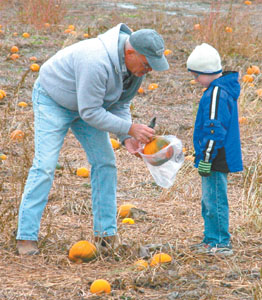By Shelley Grieshop
sgrieshop@dailystandard.com COLDWATER -- Soggy fields, rodents and fungi have made finding the perfect pumpkin for a jack-o-lantern a little more difficult this fall.

The state of Ohio -- ranking third in the nation last year for the largest pumpkin crop -- may have to bow out of the top standings for 2006, said Jim Jasinski, a researcher for the Ohio State University in South Charleston, east of Dayton.
"We've had losses up to 95 percent in our research crops this year," Jasinski told The Daily Standard on Friday.
Around the state, as in the local area, pumpkin yields were mixed depending on rain amounts but nearly everyone experienced more problems this year than in previous ones, he said. One of the key issues frustrating researchers also affected local pumpkin grower Jim Menchhofer of Menchhofer's Fall Market in rural Coldwater.
"Mice damaged a lot of our pumpkins. I think they were probably trying to get to the moisture inside; you could see gnaw marks on some of them," said Menchhofer, who harvested only about a quarter of what he planted this year. Jasinski said mice didn't wait for the pumpkin plants to sprout in the research fields. They chewed through the pumpkin seeds shortly after planting so they could munch on the inside or "embryo."
Menchhofer, who grows several pumpkin varieties, gourds and apples, plants ryegrass in the pumpkin field in the fall to keep weeds down and the fruit off the ground when it sprouts. A wet spring that hampered other area crops also prevented some pumpkin seeds from emerging through the soil, he said.
The "U-pick" field at the Wabash Road farm was plentiful enough but the family was forced to purchase extra pumpkins from a grower in Hagerstown, Ind., to keep a healthy supply for their market, Menchhofer said.
Jasinski said the use of ryegrass and the practice of no-till fields are a successful combination that helps prevent soil-born fungi called fusarium -- a big problem for pumpkin growers in Ohio. The downside, however, is that infrequent plowing may keep mice burrows undisturbed from year to year, leading to larger populations.
"And there's not much you can do legally to combat them (mice)," Jasinski explained.
The Western Agricultural Research Station where Jasinski works is currently experimenting with products like garlic sprinkles, garlic oil, capsaicin oil and Bitrex, supposedly the world's most bitter substance, to help eliminate rodent problems in the future, he said.
The 2005 pumpkin crop brought Ohio growers more than $26,000 in profits, up 121 percent from a rainy 2004 season.
The top pumpkin growing states by acreage harvested includes number one and two, Illinois (13,000) and Pennsylvania (7,500), followed by Ohio (7,400), Michigan (6,100), California (5,500) and New York (5,300). |

